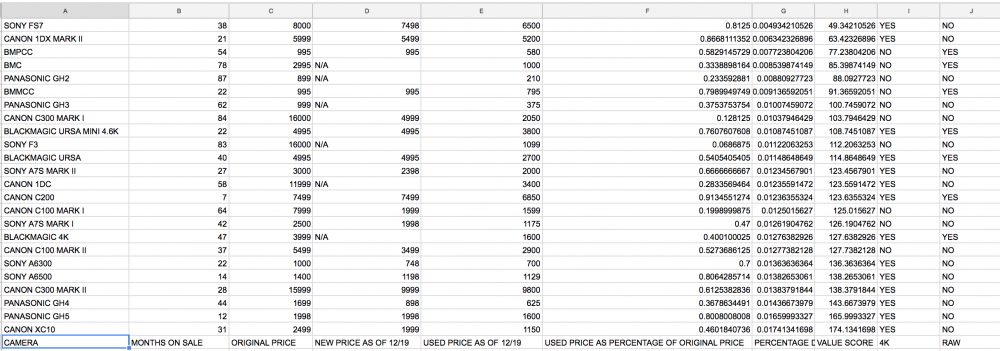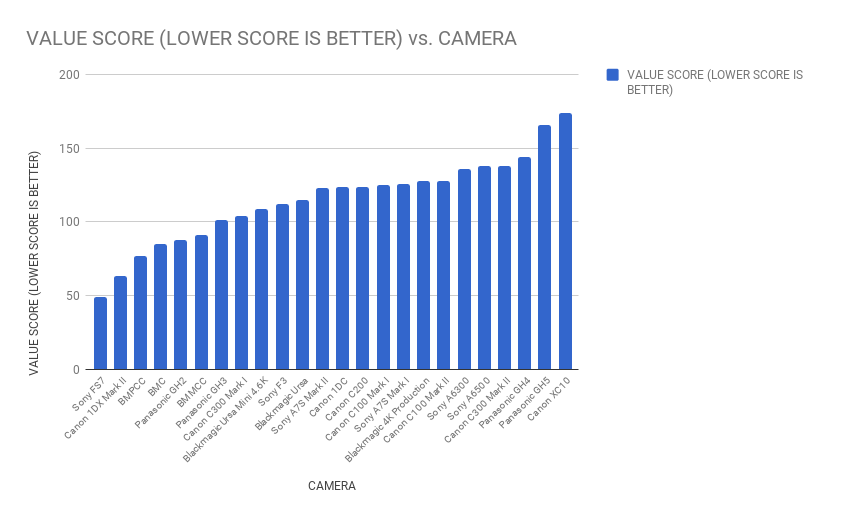Leaderboard
Popular Content
Showing content with the highest reputation on 12/25/2017 in all areas
-

Canon 1DC vs Canon 5D Mark IV
deezid and one other reacted to webrunner5 for a topic
Most of the cheap C500's I have seen are PL mount, and by the time you buy a external recorder to do 4k well, you might as well buy a stripped down C200 and get DPAF to boot.2 points -
We all know that cameras are terrible investments. They instantly lose value when you open them and they’re no longer new-in-box, and then they steadily lose value over time. It really only makes sense to think of a camera as an investment if you’re a business buying a camera that will directly impact your ability to get work or if you’re a collector selling rare antiques. Otherwise, you can only plan on losing money on whatever camera that you buy. Buying a camera and expecting it to increase in value is usually really silly. At the same time though, cameras lose values at different rates. Some cameras command used rates very near their launch prices, and other cameras sell for way less than their initial price a year after launch. Importantly though, I think the value of a camera over time can show how forward-looking the company that launched the camera was with that model when it released it. A camera released in 2014 that’s still relevant right now had valuable features in 2014, but is also is still competitive in some way in 2017 (or 2018). I’m thinking that the forward-looking value of a camera can be calculated based on a few points of data: first, how long the camera has been on the market; second, how much the camera cost when it was initially released; and third, how much the camera is selling for used today. In short, I think the difference between what a camera sold for when it was released and what you can buy it for used today can show how competitive the camera is relative to other cameras. So, what I did was to search out data for some of the most commonly used cameras for video and analyze how old they are, how much they sold for when first released, and how much they sell for now. The short version is that I made a Google Sheet and compared the values of cameras over time to see which cameras held their values best over the months they’ve been on the market. The long of it is this: I made ten columns in a Google Sheet. The first column identifies the camera. I chose cameras that are most discussed on the blogs that I frequent, like this one, but I purposely excluded cameras that are also super popular in photography, like the 5D Mark II and III. Their used online value might be less attached to their video functions than others here. The second column is the number of months the camera has been on sale. I used the actual “the camera is available on B&H” date whenever possible. For cameras where the announcement date and the sale date weren’t hugely different, I didn’t make a distinction. For cameras (like some Blackmagic cameras) that were announced and didn’t go on sale until months later, I used the actual “available for sale” date when I could find it. I rounded to the nearest month. The third column is the original price that the camera sold for. The fourth column is the new price as of 12/19/17 (this is mostly for my curiosity and doesn't actually figure into any of the calculations). The fifth column is the used price as of 12/19/17-12/20/17. I used the lowest “Buy-It-Now” price from eBay (US) I could find for each camera, but I only accepted cameras that I would actually purchase (if I was looking for one) based on their being used but totally functional and coming from buyers with decent feedback. The sixth column is the used price as a percentage of the initial new price. For example, a camera that debuted for $2,000 and now sells for $1,000 is selling for 50% of its initial price. The seventh column is the percentage of value lost divided by the number of months the camera has been on the market. I found the percentage of value lost by subtracting the percentage of the new price that the camera sells for used from one. The eighth column is the tiny percentage from the seventh column multiplied by 10,000 to make it more readable. I’m basically creating a “value score,” where the lowest number is the camera that has retained its value the best. The ninth and tenth columns are whether the camera shoots in 4K or raw, respectively, because I wondered whether that would make an obvious difference. This is a graph with each camera’s “value score” (the percentage drop per month multiplied by 10,000), rounded to the nearest one. Essentially, the lower the score, the less value the camera has lost over time, or in other words, the better it’s retained its value relative to the number of months it’s been on the market. Here’s all the original data. So, basically the FS7 has lost very little of its value over time, while the Canon XC10 has lost a ton of its value over time. Most cameras fall in the middle range. Interestingly, every major company has a camera in the top five, and every major company also has a camera in the bottom five. Interestingly, 1080p and 2.5K cameras do pretty well by these calculations. The BMPCC, BMC, Panasonic GH2, BMMCC, and GH3 have all held their value relatively well, while a lot of 4K cameras have lost value relatively quickly. I wondered whether raw shooting cameras would do better, but I don’t think there’s a strong correlation. I’m sure there’s some complex relationship between resolution, codec strength, lowlight ability, sensor size, marketing, and a million other factors, but I don’t know what it is. Interestingly, it’s also possible that the most popular cameras sell for lower prices relative to their new prices because so many people have bought them and used supply is high when those customers decide to move on to new cameras. However each camera has maintained its value, I think the cameras with low scores were (are) futuristic in some way. They have to be to still be relevant today, or to have still been relevant so recently (in the case of the GH2). There’s a lot of limitations to my analysis. It’s mostly for fun and to drive discussion. First, the eBay prices are a tiny sample over two days. I’ve seen cameras go for a lot lower than the prices listed here. I saw a BMMCC go for $550 a few days ago, but when I actually did the analysis the lowest price I could find was $800. That’s a substantial change, but I wanted to take all the prices from one window of time. Second, I don’t think eBay is (usually) actually the lowest price source for buying a camera used. The cheapest BMPCC I could find is $580, but there’s one on BMCUser now that’s less and comes with a cage. I’m totally open too to the fact that my math might be less than perfect. I’m not a statistician. I’m just a camera nerd with love for data. Please feel free to point out how I could make it better or if it’s all not valid at all. Or, please let me know if I’ve missed major dates, miscalculated months, or mistook the initial price. I threw this together pretty quickly out of curiosity and can fix it. I’m not picking on any particular camera. I’ve almost bought an XC10 a few times. At the end of the day, whatever camera you buy needs to fit your needs, and the idea that it might retain value isn’t really important if it’s meeting those needs. But, some cameras hit the market and are so cutting edge that they hang on for years. My goal was to look backward with data to see which cameras those were.1 point
-

Canon 1DC vs Canon 5D Mark IV
IronFilm reacted to Michael Ma for a topic
Hopefully this video will show dissuade you from buying a 5D4 if you need 4k. From my personal tests, the rolling shutter is so bad you can even see the lag when doing a closeup on someone's face even when you're not panning. They compare the rolling shutter to the 1DX2 which is far better in 4K when it comes to rolling shutter.1 point -
Hey, thanks. It saved my butt for recent travel, by its portability.1 point
-
Panasonic GH5 - all is revealed!
tweak reacted to Fritz Pierre for a topic
It will probably become clear when he tries to sell another SLRMagic Rangefinder??1 point -
@jonpais Wish I could help. I must admit that I'm still confused about the correlation between the settings (preferences: raw values, library color space, project color space, HDR tools). I have a lot of LOG footage (own slog2, own BM Pocket LOG, FS7 slog3 from my buddy, downloaded Vlog and HLG clips from GH5, some C200 clips had been RAW but sadly converted to ProRes444). Some were radically ETTR'd and surely look overexposed in the browser. However, I can stuff the values between 0 and 100 in the (rec_709) waveform, and nothing looks blown out, and certainly not at 90 somewhat IRE (BTW: you accidentally found the 'custom reference line': when you mouse-over an IRE-value in the waveform and then click, it sticks). You just wrote you give up already, but let me/us try to replicate the issue. I'm quite sure I had recently downloaded the clip in question (or a very similar one), called "Sigma 30mm f3.2". I can't remember where I found this clip, and whether it was V-Log or HLG (browser history deleted through clean install for HS the day 10.4 came out), but it is the most extreme clip on my whole system in that it looked so very much overexposed from the start. That was in 10.3! However, if I use the whole rec_709 pipeline, I am able to make it look normal in 10.4 with highlights hitting 100 (adjust highlights and shadows). alt+cmd+b totally fucks up everything, unuseable. FCP-Internal LUT "Panasonic V-Log" makes it automatically look pretty normal, if somewhat oversaturated to my taste, but with 'legal' values. You should let us download the clip in your screenshot and guide us through the process. New territory. Who can appreciate WCG or rec_2020 in 2017/18? Honestly, I don't know. Can't tell for sure if there's a noteworthy visual difference on my own P3 display ... And I'm sure you can do that in 10.4. Let's get to the bottom of this together. My buddy just ordered HDR interface and the Dell HDR monitor. He is on Windows and doesn't have FCP, but I'm curious to see how far he will get with Resolve. If his images will blow my mind, I know I will never ever want to be limited to rec_709 (although my wedding videographer's clientele isn't asking for HDR).1 point
-
1 point
-
1 point
-
Plus you could get a non-Metabones focal reducer which is 0.71x, such as the RJ Lens Turbo which is dirt dirt cheap. Is what I use myself with my MFT cameras. This is one of the benefits of the Nikon lens system, their plain adapters are a tiny fraction of the cost of a Canon adapter. Yeah, and if you're going to buy the GH4 for the benefits its has (such as anamorphic or 10bit external) then you likely are not on a budget for a G85 anyway! And you should just buy a GH5 instead. So in short: a G85 beats a GH4 in every way* (Exceptions: being in a few ways that are usually not relevant to a G85 buyer anyway, and if they matter to you... you should buy a GH5 instead! For instance who'd buy a GH4 for the 10bit external today?! For the cost of a GH4 + 4K recorder, you could just buy a GH5!!))1 point
-
Panasonic seems to be announcing something "BIG" on December 15
Kisaha reacted to Fritz Pierre for a topic
Though you feel you don't need or want 4K, perhaps the article I copied from Reduser will explain why 4K to you....it has as much to to as anything that (although not to you) to most people the holy grail in digital cameras is to get to the look of S35....this is in both the image, and the projectibilty....where no digital camera can BE the same image as S35 film, camera makers and users can aspire to get as close to that image as possible....so perhaps to those who don't want or NEED 4K, this article somewhat clarifies why to others 4K matters...in simple terms, they are perhaps hoping to get closer to that holy grail! No matter how it is cut – film material always possesses the same performance data: the smallest reproducible detail (20 % modu* lation) on a camera film negative (up to 200 ASA) is about 0.006 mm. We can think of this as the size of film’s “pixels”, a concept that is well known from electronic image processing. And it does not matter if it is 16 mm, 35 mm, or 65 mm film: the crys* talline structure of the emulsion is indepen* dent of the film format. Also, the transmission capability of the imaging lens is generally high enough to transfer this spatial frequency (0.006 mm = 80 lp/mm) almost equally well for all film formats. The film format becomes relevant, however, when it comes to how many such very small details are to be stored on its surface – that is the question of the total available storage capacity. In the table below the number of “pixels” are indicated for the image’s width and height. Based on the smallest reproducible detail of 0.006 mm the table gives an overview of the storage capacity of different film formats. S16 2058 × 1237 pixels S35 4153 × 3112 pixels 65 8746 × 3835 pixels this is taken from a very detailed article about sharpness and resolution from Arri. +100!....I have never sat in a single production meeting where a DP has said, I can't get this shot because it's too dark or I can't get that steadycam shot because AF is not good enough...lol...the director wants answers in that meeting then and there...if the DP did not know, they would leave the meeting rather rapidly to be replaced by someone who did and could...there are no shortcuts to excellence...someone who rolls 200 takes on a digital camera just because the media is so cheap, is not accomplished....they are hoping for a fluke...and if they did get the shot, it would not be repeatable for them, because they'd have no idea what they did...again, there are no shortcuts to being good at something....and the camera can't do that for you either....it's easy to luck onto a shot that lasts 20 seconds and to post it on a forum and to receive lots of ooohs and aaahs...the expert can do that throughout a 21/2 feature and in that lies the major difference!1 point -
Panasonic seems to be announcing something "BIG" on December 15
kidzrevil reacted to Mattias Burling for a topic
I know plenty of people would love it to be true. But there is no way getting around it. The reason the 1DC or C100 isn't hacked is because no one knows how. Otherwise it would be done. And all the "some guy told a friend's cousin" isnt gonna change that.1 point -
Panasonic GH5 - all is revealed!
Chrille reacted to Fritz Pierre for a topic
@Chrille...presuming you're actually asking for advice, I would say no, based on your impressions/ comments of the GH5 you should definitely not buy one.1 point -

Panasonic GH5 - all is revealed!
Chrille reacted to webrunner5 for a topic
Kind of funny for me to hear Rap music in German! Works fine. I think I would at least wait for this GH5s thingy to see what it is. Might be the best thing since sliced bread for the money? Trouble with the BMPCC is low light and it is not the easiest thing to handle. I sort of like the BMCC better for production. But you are not going to run n gun with it like you sort of can with the BMPCC. Yeah that seems crazy the a Sony a7r II would be noisy?? They are almost as good as the A7s. Yeah not a lot I have seen either that is Cine looking out of a GH5 compared to what you get form a BM product. But it does have a wealth of features in it not many cameras have. I think better LuTs will come out. That Arri LuT on here Sage has looks great for them.1 point -
Panasonic GH5 10bit vs 8bit
webrunner5 reacted to sam rides a mtb for a topic
Not my footage, but one example:1 point -
Ive done tests and have found when it comes to baked in profiles the 5DIV actually appears to have better IQ than 1DC. I should do a real review/test and see. I haven't tested the 5DIV Canon Log yet. Im sure its great1 point
-
Panasonic GH5 10bit vs 8bit
webrunner5 reacted to Simon Shasha for a topic
The GH5 is the first time I am willing to trade dynamic-range for ergonomics. I am absolutely sick of rigging up cameras, if not with external monitors, than with shoulder-rigs and whatnot. For my personal shooting style, the 5-Axis on-sensor IBIS, high-res EVF and LCD, and 10-bit internal, make up for the lack of dynamic-range and usable 12,800ISO (which I wouldn't even use, anyway).1 point




